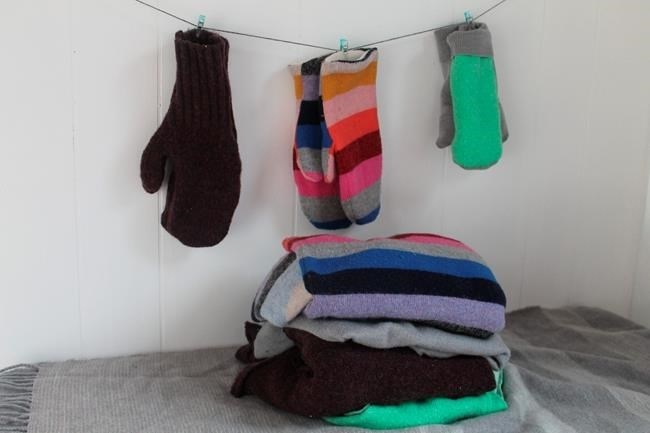
This Feb. 4, 2020 photo taken in Hopkinton, N.H., shows three pairs of handmade mittens, each constructed from sweaters using slightly different techniques. If winter is lasting longer than the groundhog predicted where you live, consider restocking your mitten supply and clearing out your closet at the same time. Instead of tossing stained or accidentally shrunken sweaters, turn them into cozy mittens.
Image Credit: AP Photo/Holly Ramer
February 19, 2020 - 5:00 AM
CONCORD, N.H. - A certain groundhog’s prediction notwithstanding, there’s plenty of winter left where I live in New Hampshire. That means it’s time to restock my supply of mittens, an alarming number of which seem to disappeared since the temperature started to dip last fall.
Luckily, in addition to losing accessories, I also have a habit of accidentally shrinking or staining sweaters, which makes them perfect for upcycling into handy hand warmers.
I found numerous patterns and tutorials online for turning old sweaters into mittens, some of them as simple as tracing around a hand and sewing a single seam. Others were more complex, involving multiple pieces, linings and cuffs. If you’re less accident-prone than me and don’t have a pile of usable sweaters, check out your local thrift store for inexpensive options. Sweaters with plenty of ribbing at the cuffs and hems are particularly useful for mitten-making. Wool sweaters are ideal in terms of warmth, especially if they’ve been shrunk and felted to make an even more durable fabric.
Here’s what I found, with each method rated from 1 to 10, with 10 indicating the least expensive, easiest and best results:
TRACE AND CUT:
If you remember tracing your hand to draw a turkey in kindergarten, this is even easier. Following the instructions on a craft blog called Practically Functional, I made a simple pattern by tracing around my hand on a piece of paper, cutting out the shape and placing it along the bottom edge of an inside-out sweater. I cut around the pattern and then sewed around the shape, leaving the bottom open. While it took me closer to 15 minutes than the 10 minutes promised in the tutorial, this was indeed a super fast way to make a pair of mittens. But the result was the least professional looking of the three methods, and the least warm, given that there is no lining. Still, this would be a good way to use up old sweaters, and in climates warmer than New England, a single layer might be plenty.
COST: 9
EASE: 9
RESULTS: 5
FLEECE LINED:
I next tried a tutorial on a blog called Five Green Acres that was a step up in both style and function, but also included a lot more steps. Using the downloadable patterns, I cut out three pieces of sweater for each mitten: a mitten back plus two pieces that get sewn together to become the palm and thumb. The same process is followed to construct a fleece lining layer. The lining is placed over the finished sweater layer, right sides together, and the two pieces are sewn together at the cuff, leaving a small opening for turning so the lining can then be pushed down into the mitten. None of the steps would be difficult for anyone with a bit of sewing experience, but between cutting out six pieces and sewing nine seams, this project took just under an hour for one pair of mittens. I had fleece on hand, but purchasing it would add a bit to the cost. The finished product, however, is warm, and more tailored-looking than the first pair of mittens. I used the large child/small adult size, and found it fit well, though the thumb could be a bit longer.
COST: 7
EASE: 7
RESULTS: 7
LINED AND CUFFED:
The most involved tutorial I tried was written by Beth Huntington of the Renegade Seamstress blog, and hosted on the eHow.com website. While the instructions call for using two co-ordinating sweaters, one sweater would also work. The steps are similar to the other fleece-lined mitten tutorial, though the shapes of the pattern pieces are slightly different. The main difference is this technique involved cutting off the cuffs of a sweater and attaching them to the mitten linings. That way, instead of sewing the lining and outer mittens together, the lining is just tucked into the mitten and the cuff extends out and folds over the mitten exterior. Though this technique requires sweaters with narrow or ribbed cuffs (I had one sweater with bell-shaped sleeves that would not be appropriate), it actually was easier than trying to sew the lining and outer mitten together in the previous tutorial. The finished result was more polished-looking, and depending on the sweaters used, could be a way to mix and match different colours and patterns. My main problem with this technique was the pattern only comes in one size, which turned out to be a bit small for my hands.
COST: 7
EASE: 8
RESULTS: 8
News from © The Associated Press, 2020